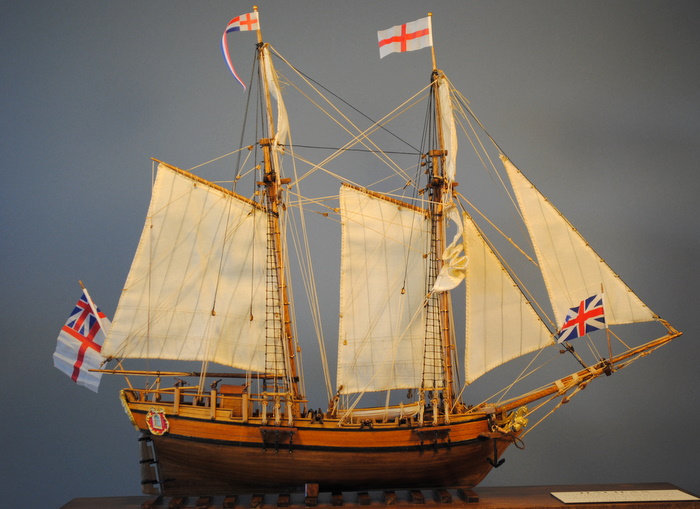Halifax, British Navy Sloop (1768)
Particulars
Vessel type: Topsail Schooner
Builder: Likely Halifax Navy Yard; managed by Joseph Grey
Launched: late September 1765
Date Modified: 1768 in Portmouth, England, purchased by British Royal Navy on October, 12 1768
Date Wrecked: February 15, 1775, possibly salvaged
Length on deck: 58 feet
Length over all: 99 feet
Beam: 18 feet 3 inches
Depth: 8 feet 10 inches
Draft: about 8 feet
Construction Material: Wood
Rig Type: Schooner
Crew Size: about 30
Passenger Capacity: Undoubtedly she carried passengers in primitive conditions.
Propulsion: Sail only
Cruising Speed: 8 knots in good conditions
Maximum Speed: 11 knots in the very best conditions
Armament: 6 three-pounders, 8, later 12, ½-pounder swivels
Vessel Description
This vessel was initially built as a packet (a vessel that sails on a schedule between ports) but later converted to a schooner rigged sloop for naval patrols and armed. Her conversion took place in Portsmouth, England and alterations included raising the cabin deck to increase space in the cabin and raising of the bulwarks to allow for gunport and fighting protection. Her original design allowed for quick transit with a small cargo and a limited amount of passengers. Those qualities also made her excellent for naval patrols against smugglers and dissidents. The schooner rig is an early version that still retained significant square sails.
Vessel History
Originally named Nova Scotia Packet, she launched in September 1765 with her first voyage commencing on October 15, 1765 with Benjamin Green, Jr. as captain.
Every eight days she sailed between Halifax and Boston, weather permitting, making a total of twenty-three round trips as a merchant vessel.
Commodore Samuel Hood chartered her in July 1768 for transit to Portsmouth, England from Halifax and recommended her purchase by the Royal Navy.
The Royal Navy bought her on October 12, 1768 for coastal patrols off New England, which became increasingly resistant toward the British government. Lieutenant Samuel Scott commanded her and sailed back to North American in 1769.
Later that years she confiscated John Hancock’s Liberty. She returned to Great Britain in December 1770 but sailed back again under the command of Lieutenant Abraham Crespin in 1771. Another commander included Lieutenant Jacob Rodgers in 1773. Under the command of Lieutenant Joseph Nunn she sank on February 15 near Machais, Maine.
The Model
This model was built from a kit by Henry Schaefer in 2008 to a scale of 1:54.

